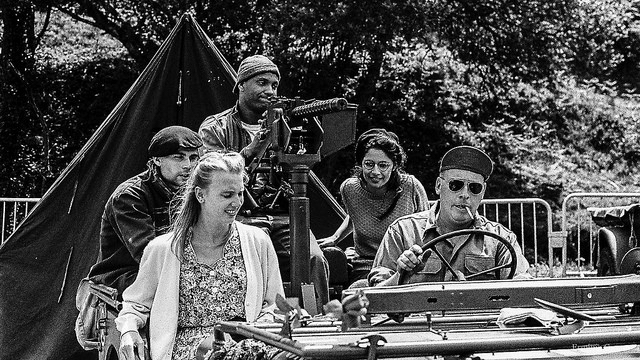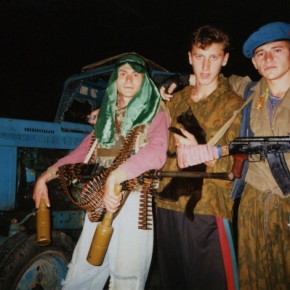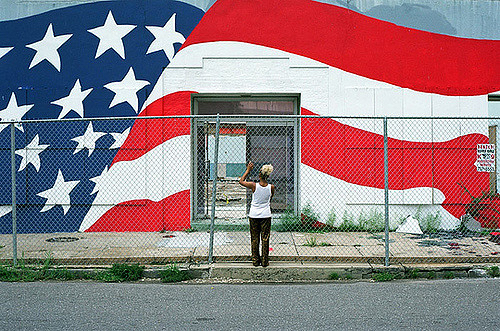By 1948, black troops, for so long limited to a few job categories, could be found in a majority of military occupational fields. The officer corps was open to all without the restrictions of a racial quota, and while a quota for enlisted men still existed, all racial distinctions in standards of enlistment were gone.
The Army was replacing white officers in black units with Negroes as fast as qualified black replacements became available. And more were qualifying every day.
By 30 June 1948, the Army had almost 1,000 black commissioned officers, 5 warrant officers, and 67 nurses serving with over 65,000 enlisted men and women.
But here, in the eyes of the Army’s critics, was the rub: after three years of racial reform segregation not only remained but had been perfected. No longer would the Army be plagued with the vast all-black divisions that had segregated thousands of Negroes in an admittedly inefficient and often embarrassing manner. Instead, Negroes would be segregated in more easily managed hundreds. By limiting integration to the battalion level (the lowest self-sustaining unit in the Army system), the Army could guarantee the separation of the races in eating, sleeping, and general social matters and still hope to escape some of the obvious discrimination of separate units by making the black battalions organic elements of larger white units.
The Army’s scheme did not work. Schooling and specialty occupations aside, segregation quite obviously remained the essential fact of military life and social intercourse for the majority of black soldiers, and all the evidence of reasonable and genuine reform that came about under the Gillem Board policy went aglimmering. The Army was in for some rough years with its critics.
But why were the Army’s senior officers, experienced leaders at the pinnacle of their careers and dedicated to the well-being of the institution they served, so reluctant to part with segregation? Why did they cling to an institution abandoned by the Navy and the Air Force, the target of the civil rights movement and its allies in Congress, and by any reasonable judgment so costly in terms of efficient organization? The answers lie in the reasoned defense of their position developed by these men during the long controversy over the use of black troops and so often presented in public statements and documents. Arguments for continued segregation fell into four general categories.
First, segregation was necessary to preserve the internal stability of the Army. Prejudice was a condition of American society, General of the Army Dwight D. Eisenhower told a Senate committee in 1948, and the Army “is merely one of the mirrors that holds up to our faces the United States of America.” Since society separated the races, it followed that if the Army allowed black and white soldiers to live and socialize together it ran the very real risk of riots and racial disturbances which could disrupt its vital functions. Remembering the contribution of black platoons to the war in Europe, General Eisenhower, for his part, was willing to accept the risk and integrate the races by platoons, believing that the social problems “can be handled,” particularly on the large posts.
Nevertheless he made no move toward integrating by platoons while he was Chief of Staff. Later he explained that “the possibility of applying this lesson [World War II integration of Negro platoons] to the peacetime Army came up again and again.” Objection involved primarily the social side of the soldier’s life. It was argued that through integration we would get into all kinds of difficulty in staging soldiers’ dances and other social events. At that time we were primarily occupied in responding to America’s determination “to get the soldiers home”—so, as I recall, little progress toward integration was made during that period.

“Liquor and women,” Lt. Gen. John C. H. Lee pronounced, were the major ingredients of racial turmoil in the Army. Although General Lee had been a prime mover in the wartime integration of combat platoons, he wanted the Army to avoid social integration because of the disturbances he believed would attend it. As General Omar N. Bradley saw it, the Army could integrate its training programs but not the soldier’s social life. Hope of progress would be destroyed if integration was pushed too fast. Bradley summed up his postwar attitude very simply: “I said let’s go easy—as fast as we can.”
Second, segregation was an efficient way to isolate the poorly educated and undertrained black soldier, especially one with a combat occupational specialty. To integrate Negroes into white combat units, already dangerously under strength, would threaten the Army’s fighting ability. When he was Chief of Staff, Eisenhower thought many of the problems associated with black soldiers, problems of morale, health, and discipline, were problems of education, and that the Negro was capable of change.
“I believe,” he said, “that a Negro can improve his standing and his social standing and his respect for certain of the standards that we observe, just as well as we can.” Lt. Gen. Wade H. Haislip, the Deputy Chief of Staff for Administration, concluded that the Army’s racial mission was education. All that Circular 124 meant, he explained, “was that we had to begin educating the Negro soldiers so they could be mixed sometime in the future.” Bradley observed in agreement that “as you begin to get better educated Negroes in the service,” there is “more reason to integrate.” The Army was pledged to accept Negroes and to give them a wide choice of assignment, but until their education and training improved they had to be isolated.
Third, segregation was the only way to provide equal treatment and opportunity for black troops. Defending this paternalistic argument, Eisenhower told the Senate:
In general, the Negro is less well educated … and if you make a complete amalgamation, what you are going to have is in every company the Negro is going to be relegated to the minor jobs, and he is never going to get his promotion to such grades as technical sergeant, master sergeant, and so on, because the competition is too tough. If, on the other hand, he is in smaller units of his own, he can go up to that rate, and I believe he is entitled to the chance to show his own wares.

Fourth, segregation was necessary because segments of American society with powerful representatives in Congress were violently opposed to mixing the races. Bradley explained that integration was part of social evolution, and he was afraid that the Army might move too fast for certain sections of the country. “I thought in 1948 that they were ready in the North,” he added, “but not in the South.”
The south “learned over the years that mixing the races was a vast problem.” Bradley continued, “so any change in the Army would be a big step in the South.” General Haislip reasoned, you “just can’t do it all of a sudden.” As for the influence of those opposed to maintaining the Army’s social status quo, Haislip, who was the Vice Chief of Staff during part of the Gillem Board period, recalled that “everybody was floundering around, trying to find the right thing to do. I didn’t lose any sleep over it [charges of discrimination].”
General Eisenhower, as he did so often during his career, accurately distilled the thinking of his associates: “I believe that the human race may finally grow up to the point where it [race relations] will not be a problem. It [the race problem] will disappear through education, through mutual respect, and so on. But I do believe that if we attempt merely by passing a lot of laws to force someone to like someone else, we are just going to get into trouble. On the other hand, I do not by any means hold out for this extreme segregation as I said when I first joined the Army 38 years ago.”
These arguments might be specious, as a White House committee would later demonstrate, but they were not necessarily guileful, for they were the heartfelt opinions of many of the Army’s leaders, opinions shared by officials of the other services. These men were probably blind to the racism implicit in their policies, a racism nurtured by military tradition. Education and environment had fostered in these career officers a reverence for tradition.
Why should the Army, these traditionalists might ask, abandon its black units, some with histories stretching back almost a century? Why should the ordered social life of the Army post, for so long a mirror of the segregated society of most civilian communities, be so uncomfortably changed? The fact that integration had never really been tried before made it fraught with peril, and all the forces of military tradition conspired to support the old ways.
What had gone unnoticed by Army planners was the subtle change in the attitude of the white enlisted man toward integration. Opinion surveys were rare in an institution dedicated to the concept of military discipline, but nevertheless in the five years following the war several surveys were made of the racial views of white troops (the views of black soldiers were ignored, probably on the assumption that all Negroes favored integration).
In 1946, just as the Gillem Board policy was being enunciated, the Army staff found enlisted men in substantial agreement on segregation. Although most of those surveyed supported the expanded use of Negroes in the Army, an overwhelming majority voted for the principle of having racially separate working and living arrangements. Yet the pollsters found much less opposition to integration when they put their questions on a personal basis—”How do you feel about…?” Only southerners as a group registered a clear majority for segregated working conditions. The survey also revealed another encouraging portent: most of the opposition to integration existed among older and less educated men.
Three years later the Secretary of Defense sponsored another survey of enlisted opinion on segregation. This time less than a third of those questioned were opposed to integrated working conditions and some 40 percent were not “definitely opposed” to complete integration of both working and living arrangements. Again men from all areas tended to endorse integration as their educational level rose; opposition, on the other hand, centered in 1949 among the chronic complainers and those who had never worked with Negroes.
In discussing prejudice and discrimination it is necessary to compare the Army with the rest of American society. Examining the question of race relations in the Army runs the risk of distorting the importance given the subject by the nation as a whole in the postwar period. While resistance to segregation was undoubtedly growing in the black community and among an increasing number of progressives in the white community, there was as yet no widespread awareness of the problem and certainly no concerted public effort to end it.
This lack of perception might be particularly justified in the case of Army officers, for few of them had any experience with black soldiers and most undoubtedly were not given to wide reading and reflecting on the subject of race relations. Moreover, the realities of military life tended to insulate Army officers from the main currents of American society. Frequently transferred and therefore without roots in the civilian community, isolated for years at a time in overseas assignments, their social life often centered in the military garrison, officers might well have been less aware of racial discrimination.
Perhaps because of the insulation imposed on officers by their duties, the Army’s leaders were achieving reforms far beyond those accepted elsewhere in American society. Few national organizations and industries could match the Army in 1948 for the number of Negroes employed, the breadth of responsibility given them, and the variety of their training and occupations. Looked at in this light, the Army of 1948 and the men who led it could with considerable justification be classed as a progressive force in the fight for racial justice.
Adapted from Integration of the Armed Forces, 1940-1965, by Morris J MacGregor, Jr. Photographs courtesy of Etienne Valois, Paul Thownsend, and John Tewell. Published under a Creative Commons license.





